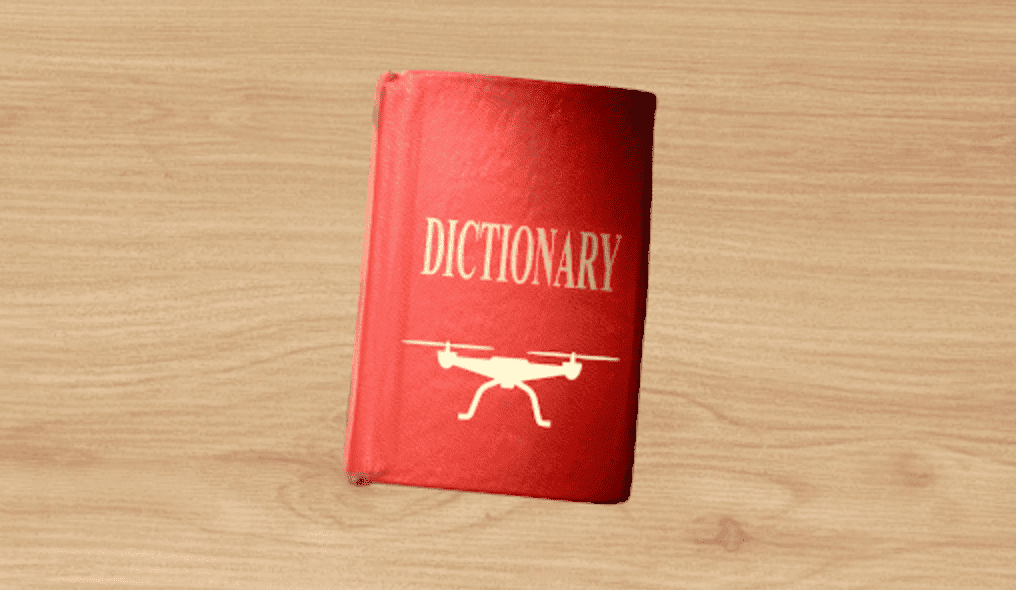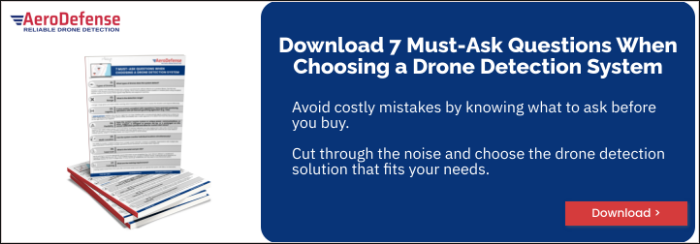Summary: This counter-UAS glossary defines key terms in drone detection, helping users understand the technology used to identify, track, and mitigate aerial threats.
Welcome to our quick guide on Counter-UAS terminologies and definitions—a roadmap to navigate the evolving landscape of aerial security.
As drones become increasingly ubiquitous, understanding the terminology surrounding their detection is crucial for ensuring safety, privacy, and security.
From Radio Frequency (RF) systems to mitigation tools, this guide aims to demystify the Counter-UAS jargon, providing clarity on the technologies and methodologies used to detect and mitigate potential drone threats in various environments.
Whether you’re a security professional, a technologist, or someone intrigued by the fascinating world of drone detection, this compilation of terms will serve as an invaluable resource in deciphering this complex field.
Counter-UAS
Counter-UAS (C-UAS)
Technologies and strategies to disable, destroy, or otherwise mitigate unauthorized drones.
Drone Interceptor / Capture Drone
A drone designed to intercept and neutralize unauthorized drones, often using nets or other mechanisms. Requires an advanced waiver from FAA regulations to operate.
Jamming
Disrupting a drone’s communication or GPS signals, forcing it to land or lose control. Requires an advanced waiver from FAA, FCC, and DOJ regulations to operate.
No-Fly Zone
Designated areas where drone flights are restricted by law, regulation, or technological enforcement. While the FAA strictly controls flight zones, organizations can pass laws to control sUAS take-off and landing areas.
Spoofing
Sending false GPS or control signals to mislead and redirect a drone or defeat a Drone Detection System. Requires advanced waiver from FAA, FCC, and DOJ regulations to operate.
Drone Detection
Drone Detection is about awareness and intelligence. Using technologies like RF, radar, cameras, or acoustic systems, detection identifies, locates, and tracks drones—and often their pilots—in or near protected airspace. This awareness enables agencies to assess potential threats, coordinate responses, and take informed action.
Drone Mitigation
Drone Mitigation is about intervention. Once a drone is confirmed as unauthorized, mitigation tools can disable, redirect, or capture it. Techniques range from electronic methods (like jamming or spoofing) to physical ones (such as nets, intercept drones, or directed energy systems).
However, only a few federal agencies — including the Department of Defense, Department of Energy, Department of Justice, and Department of Homeland Security — are legally authorized to use these measures.
In short: detection equips you to understand and respond; mitigation provides tools for intervention when a drone poses an actual threat.
Drone Detection & Sensing
Acoustic Detection
Drone detection via a microphone-based sensor(s) that detect sound patterns attributed to drones’ motors or propellers.
Active RF: Radar
Radar systems emit short pulses of radio waves that reflect off objects. The reflections are measured to detect, characterize, and track airborne objects. The frequency used by the radar will impact range and target resolution. For example, a long-range radar used to detect large objects such as aircraft will use a lower frequency than a radar designed to detect small objects such as sUAS. The higher frequency will have the ability to pick up small fluctuations created by spinning rotors, but will have a much shorter range and be more impacted by weather and environmental clutter, such as birds.
ADS-B (Automatic Dependent Surveillance–Broadcast)
A surveillance technology used in manned aviation that automatically broadcasts an aircraft’s position, velocity, and identification information to ground stations and nearby aircraft to improve airspace safety and situational awareness.
Directional Antenna
Refers to antennas or sensors that receive or transmit signals in a cone. Directional antennas are often deployed in an array that may cover 360 degrees.
Electro-Optical (EO) Camera
Sensors that detect electromagnetic waves in the visible light spectrum. Used to visually identify drones.
FAA Remote ID Broadcast
FAA rule requiring drones to broadcast identification information. The information required to be broadcast includes, but is not limited to, an ID (typically serial number), drone location and altitude, pilot location, speed every one second while in flight. Third-party devices that range from consumer cell phone apps to commercial long-range sensors receive the drones’ Remote ID broadcasts.
Fixed Sensor
A permanently installed sensor that monitors drones at a specific location.
Geofencing
A software feature that restricts drones from entering certain airspace, such as airports or military zones. DJI replaced the geofencing system—previously preventing takeoff or flight in restricted airspace—with “Enhanced Warning Zones”. These zones now simply warn operators but do not block flights.
Infrared (IR) Camera
Sensors that detect electromagnetic waves in the infrared spectrum, revealing drones by heat signatures typically only used at night.
Mobile Sensor
A sensor that can be mounted in a vehicle or platform that can be relocated. The sensor may operate while stationary or in motion.
Omni-Directional Antenna
Refers to antennas or sensors that receive or transmit signals equally in all directions.
Passive RF: Demodulation or Signal Intelligence
The process of receiving and extracting information from an RF signal that is typically not intended for public consumption, unlike Remote ID. Passive RF drone detection systems that extract any private signal information require advanced waivers from Federal wiretapping laws. Generally requires prior knowledge of the modulation, coding, and encryption of the target signal; any changes will evade detection. This type of system is typically located by reading the telemetry data of the target if it exists.
Passive RF: Spectrum Sensing
Spectrum Sensing RF detection refers to technology that passively monitors the RF spectrum to identify drone activity. Spectrum Sensing RF systems analyze physical RF signal characteristics to detect the presence of drone signals. Once a signal is detected, geolocation may take place with other methods such as triangulation/trilateration. Some systems use directional antennas to perform Direction Finding (DF).
Portable Sensor
A sensor that can be easily relocated, typically by one person. The sensor is suitable for stationary operation, generally on a rooftop or tripod.
Radio Frequency (RF)
Non-Remote ID RF drone detection can be passive (relies on drone transmissions) or active (radar).
Sensor Network
Multiple sensors working together to detect, track, and identify drones.
Drone Mitigation
Directed Energy (DEW)
High-powered energy systems (such as lasers or microwave beams) are designed to disable or destroy drones in flight. Requires significant regulatory oversight and is typically restricted to military or specialized federal use.
Drone Interceptor / Capture Drone
An aerial drone designed to intercept and neutralize unauthorized drones, often using nets, grappling hooks, or similar mechanisms. Requires an advanced waiver from FAA regulations to operate.
Jamming
Disrupting a drone’s communication or GPS signals, forcing it to land or lose control. Requires an advanced waiver from FAA, FCC, and DOJ regulations to operate.
Kill Chain
The sequence of steps in dealing with a drone threat. Depending upon the organization, steps may differ, but typically include Find, Locate, Track, Target, Engage, and Assess.
Net Gun / Net Capture
A physical method of capturing drones by entangling them in a net, either from the ground or air. Requires an advanced waiver from FAA regulations to operate.
No-Fly Zone Enforcement
The application of geofencing or counter-UAS technologies to actively prevent drones from entering restricted areas. Goes beyond software warnings to include electronic or physical enforcement.
Spoofing
Sending false GPS or control signals to mislead and redirect a drone or defeat a drone detection system. Requires an advanced waiver from FAA, FCC, and DOJ regulations to operate.
Drone Types & Components
Drone Types
Fixed-Wing Drone
A drone with wings enabling glide capabilities, offering longer endurance and range compared to multirotors.
Multirotor Drone
A drone with multiple rotors, often attached to arms, is typically a quadcopter. Known for maneuverability and VTOL capabilities, but shorter endurance.
VTOL (Vertical Take-Off and Landing) Drone
Drones capable of vertical takeoff and landing. Some combine multirotor takeoff capabilities with fixed wings. Electric VTOL (eVTOL) is often used in discussions about Advanced Air Mobility (AAM) and the future of passenger UAS.
Drone Components
Ground Station Controller (GSC)
The ground-based device that a drone pilot uses to control the drone and monitor its flight data.
Small Unmanned/Uncrewed Aerial System (sUAS)
Commercial-type drones under 55 lbs (per FAA). Military branches use the term “sUAS” versus “UAS” to distinguish them from larger military platforms.
Unmanned/Uncrewed Aerial Vehicle (UAV)
A specific type of aircraft that operates without a human pilot on board. Often called a drone, UAVs may be remotely piloted or autonomous.
Unmanned/Uncrewed Aerial System (UAS)
A system consisting of the drone, its ground-based controller, and communication links between the two. UAS may be piloted remotely or operate autonomously.
Regulatory / Policy Terms
124n System
Under the Preventing Emerging Threats Act of 2018 (6 U.S.C. §124n), DOJ, DHS, DOE, and DOD can seek waivers to operate drone detection/mitigation systems otherwise restricted by law. Extended until Oct. 1, 2025.
Certificate of Authorization (COA)
FAA-issued authorization allowing specific drone operations outside standard Part 107 rules.
FAA Part 107
FAA regulations governing small commercial drone operations, including licensing and operational limits.
FAA UTM (Unmanned Aircraft System Traffic Management)
A system for managing drone traffic in low-altitude airspace to ensure safety and coordination.
Proposed FAA Part 108
Proposed FAA regulatory framework for commercial drones that would standardize Beyond Visual Line of Sight (BVLOS) operations.
Temporary Flight Restriction (TFR)
FAA-issued restrictions that prohibit drone flights in specific areas during events or emergencies. Note that some TFRs are permanent in nature.
Other Key Terms
Advanced Air Mobility (AAM)
The next evolution of aviation that use new technologies (like electric or hybrid propulsion, automation, and vertical takeoff/landing) to create safer, cleaner, and more efficient air transportation systems.
Airspace Awareness
Real-time knowledge of aerial activity over a specific area, critical for drone operations and security.
Beyond Visual Line-of-Sight (BVLOS)
Operations where the drone is flown beyond the pilot’s direct visual range require special authorization.
False Negative / Missed Alarm
When a system does not alarm the presence of a target that does exist.
False Positive / False Alarm
When a system mistakenly alarms the presence of a target that does not actually exist.
Library-Based Detection
Detection systems that rely on a preloaded database of drone signatures. Limited against new or custom-built drones.
Line-of-Sight (LOS)
Drone operations where the pilot maintains direct visual contact with the drone.
Threat Assessment
The evaluation of potential risks posed by a drone, based on behavior, proximity, and context.
Drone Detection/Counter-UAS FAQs
What’s the difference between drone detection and drone mitigation?
Drone detection focuses on awareness and actionable intelligence - identifying, tracking, and classifying drones, and in some cases providing the operator’s location to inform a response. Mitigation involves active measures to disrupt, redirect, or capture a drone, which in the U.S. is legally restricted to certain federal agencies.
Is it legal for private organizations to jam or spoof drones?
No. Jamming or spoofing is strictly regulated under FAA, FCC, and DOJ laws. Only authorized federal agencies (such as the Department of Defense or Department of Homeland Security) can perform these actions. Unauthorized use can result in severe penalties.
How do drone detection systems identify drones?
Drone detection systems identify drones in different ways, depending on the technology they use. While radar, visual, and acoustic methods can help confirm a drone’s presence, only RF and Remote ID detection can consistently identify the pilot-making it the most effective choice for preventing both accidental and intentional drone incursions.
Each approach has strengths and limitations, and choosing the right drone detection method depends on your environment and operational needs.
Do all drones broadcast Remote ID information?
As of March 2024, most drones weighing over 250 grams are required by the FAA to broadcast Remote ID - a kind of digital license plate that includes location, altitude, and identification information.
Why is understanding Drone Detection/Counter-UAS terminology important?
The world of drone technology and airspace security evolves rapidly. Understanding key terms helps professionals, policymakers, and the public communicate effectively about safety, compliance, and emerging threats - ensuring that airspace remains secure.

